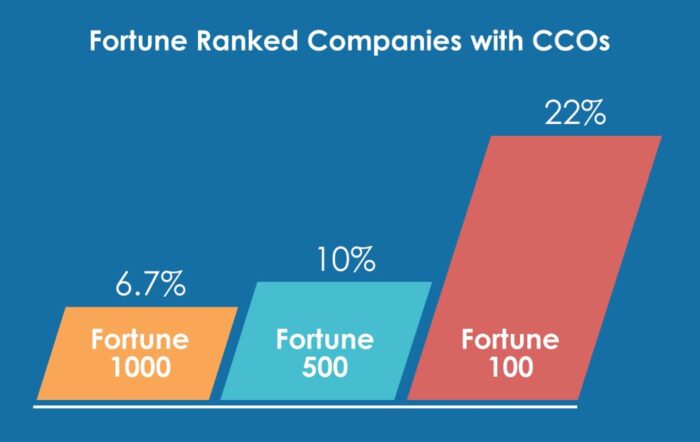The rise of Chief Customer Officers (CCO) in FMCG
The importance of the Chief Customer Officer (CCO) grows in the management teams of large organizations, particularly in FMCG.
FMCG is one of the most sensitive sectors to changes in consumer habits. The impact of changing consumer preferences is drawing a new market scenario, and the role of CCOs is to lead the direction of organizations towards a different model of relating with their customers.
The Chief Customer Officer drives the Customer journey
Improving the end-to-end customer experience is a priority in the FMCG sector. Companies competing for category leadership are aware that an unsatisfactory experience translates into a decline in market share.
The CX race is underway, and the companies that are left behind run a severe risk of losing sales and market share.
Experts like Sid Banerjee send a clear message to companies in FMCG: “Your CCO will be able to unpack what great customer experiences actually look like for your business, establishing an authentic company voice and setting clear standards for engaging with customers.”
The Chief Customer Officers, also called Chief Customer Success Officer (CCSO), have as their central mission to assess the opinions of clients in order to translate them in action plans.

To carry out their work successfully, they must work closely with different organizational functions:
- with Marketing to find customer ambassadors within the installed base.
- with Sales to make sure that the company is selling to the right customers and that the handoff from the sales team to the professional services team is seamless.
- with Product to make sure that customer feedback is being heard and that actions are being taken to improve the product and the customer experience.
- with Engineering to ensure that there is a careful process for fixing bugs when they are discovered by clients and by the customer support team.
Improving Customer Experience using Customer Intelligence
The key lies in the data. The analytical interpretation of data is vital to understand the market context and to adapt the strategies to different environments, both geographical as sociological and cultural.
Therefore, the joint work between the CCO and the CIO is strategic. Technology provides powerful tools to extract and process large amounts of information about customer behaviour. But technology, by itself, does not provide the necessary answers to develop appropriate action plans.

It is necessary to process the data from a customer-centric perspective. This implies the need to constantly update and refine the variables that organize data (responsibility of the CIO) so that they provide answers to the critical questions for the business (responsibility of the CCO).
In these complex processes, management is required that liaises technical knowledge with Emotional Intelligence to align the work of the teams and ensure that the methods are fluid and completely transversal.
Janey Whiteside, Walmart’s Chief Customer Officer , explains in this exciting podcast her experiences around the challenge of aligning the pillars of the company (consumer, product and marketing) to improve the consumer experience and anticipate future market needs.
Chief Customer Officer: from Brand Awareness to Brand Experience
In FMCG, it is widely assumed that a physical product must be enriched with digital services. The relationship with the consumer does not end when the purchase process ends. Brands must provide their customers with proposals that accompany them during the life cycle of their products.
The most innovative companies in the sector are using Hybrid Intelligence as the central axis of development of their Brand Experience proposals. Chatbots, IA, Marketing Automation, head the priority agenda of the Chief Customer Officer.
The CCO is the guardian of the relationship with the client, and their joint work with the CMO must aim to design marketing strategies in which personalization is fundamental. Personalization generates Engagement, and Engagement is the first piece of consumer loyalty.
One of the significant challenges in the competitive FMCG environment is to identify and create new categories, establishing alliances with other companies of related categories so that the contact with the consumer is Omnichannel and the relationship is memorable and lasts as long as possible.
The rise of Chief Customer Officer

According to a recent study conducted by the Chief Consumer Officer Council, the CCO is becoming a staple of modern business. The study reveals that more established brands are hiring C-level professionals who will lead the change to solve customer problems, create profitable customers, and boost the company-client relationship.
The study shows that 10% of the Fortune 500 companies have already adopted the role, a percentage that rises to 22% among Fortune 100 companies.
To succeed as a high-performance CCO is not easy. Owning the customer strategy in the everchanging technology realm can be a challenging task. According to professionals who play this role in large companies, the most necessary skills are:
- establish the horizons of company growth
- match the employee journey to the customer journey
- bring the language of the customer into the business
- identify the core values that customers appreciate and translate it into product benefits
- ability to manage today’s tasks thinking about tomorrow’s challenges
In FMCG, the CCO consolidates its position as one of the most strategic roles in the new Management Boards.

![Executive Communication with Conor Neill [Podcast] Executive Communication with Conor Neill [Podcast]](https://loftusbradford.com/wp-content/uploads/2020/03/Conversation-with-Conor-Neill-Podcast-by-Girish-Pramani-Loftus-Bradford.png)

Leave a comment